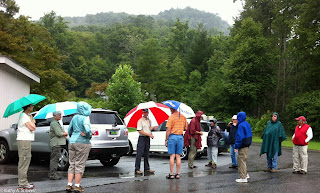Safeguarding Mountain Bogs is a unique and challenging undertaking; one we understand much better now that we have encountered the information imparted by Carrie Radcliffe in her educational and fascinating presentation on the subject and our tour of a mountain bog restoration site.
The Georgia Plant Conservation Alliance was created in 1995 and is headquartered at the State Botanical Garden of Georgia. It's a collaborative program of entities including the Atlanta Botanical Gardens, Chattahoochee Nature Center, Georgia Department of Natural Resources, The State Botanical Garden of Georgia, USDA Forest Service, the Fish and Wildlife Service and several others. This organization is the only one of its kind in the nation and recently several states have begun similar programs using it as their model.
Safeguarding mountain bogs is their signature project which focuses on the cultivation of plant materials from the known wild populations, outplanting, habitat restoration and field recovery.
According to Carrie, "Mountain bogs in the Southern Blue Ridge are more appropriately described as Southern Appalachian fens. Fens tend to occur in flat valleys and be less confined by the underlying geology and higher in nutrients than Northern bogs. Some mountain bogs do occur at high elevations, in bowl-like topographical features atop mountains. There are many classifications of these wetlands, and although they are one of the rarest habitats in the Southeast, no two are alike. What we prefer to call mountain bogs consist of seeping groundwater and surface drainage that, combined with one or more forms of natural disturbance (fire, grazing/clearing) remain open and sunny. Many are remnants of past beaver activity, and before this mammal was largely removed from our landscape there was a prevalence of these habitats in a perpetual state of creation and dilapidation and thus more habitat available for bog endemics. Sphagnum moss is the key site indicator and forms a shallow, nutrient-deprived top-layer that is more acidic than the deeper areas.
At the bog restoration and safeguarding site we visited, suitable bog habitat had been identified and selected for reclamation, management, and experimental reintroduction of imperiled plant species. Rare plants that have been outplanted at this site under the scientific advisory of the Georgia Plant Conservation Alliance include Cuthbert's turtlehead (Chelone cuthbertii), the Federally Threatened swamp pink (Helonias bullata), and the purple mountain pitcher plant (Sarracenia purpurea var. montana). Other rare species (included in Carrie's lecture) are being propagated at GPCA member gardens and will be added to this site, which is unique in that it serves as a demonstration area and a repository of genetic material for species that are otherwise restricted to one wild population.
 |
Cuthbert's turtlehead (Chelone cuthbertii)
Photo By Karen Lawrence.
|
 |
| purple mountain pitcher plant (Sarracenia purpurea var. montana) Photo By Karen Lawrence. |
Wetland species were prevalent, including the uncommon possumhaw viburnum (Viburnum nudum), naked fruit rush (Juncus gymnocarpus) and common rush (Juncus effusus), threeway sedge (Dulichium arundinaceum), wool grass (Scirpus cyperinus), and stiff cowbane (Oxypolis rigidior). Herbaceous plants that were among the bog but not restricted to wetlands included green wood orchid (Platanthera clavellata), largeflower heartleaf (Hexastylis shuttleworthii), netted chain fern (Woodwardia areolata), hayscented fern (Osmunda cinnamomea), cinnamon fern (Dennstaedtia punctilobula), boneset (Eupatorium perfoliatum), southern lobelia (Lobelia amoena), galax (Galax urceolata), and the invasive exotic annual Japanese stilt grass/ Nepal grass (Microstegium vimineum). Common woody plants in wet areas included blueberry (Vaccinium corymbosum), pepperbush (Clethra acuminata), and maleberry (Lyonia ligustrina L.). Bear huckleberry (Gaylussacia ursina), serviceberry (Amelanchier arborea), Fraser's magnolia (Magnolia fraseri), sourwood (Oxydendron arboreum), pitch pine (Pinus rigida), and black gum (Nyssa sylvatica) grow in higher, drier spots around the ecotones (transitional habitat). Woody species that invaded the bog and are being removed or taken back to the early successional stage in the surrounding uplands through the restoration process include red maple (Acer rubrum), white pine (Pinus strobus), mountain laurel (Kalmia latifolia), and rhododendron (Rhododendron maximum)."
The other rare plants not mentioned earlier which are found in mountain bogs are listed here:
According to Dan Pittillo, we saw Juncus gymnocarpus & effusus, Hexastylis cf. shuttleworthii, Galax urceolata, Viburnum nudum (lots), Eupatorium perfoliatum, Scirpus cf. cyperinus, Microstegium vimineum (aka Japanese stilt-grass) and of course lots of Sphagnum.
 |
| Woodwardia areolata pinnae Photo by Dan Pittillo |
 |
| Lobelia amoena fls by Dan Pittillo |
 |
| Oxypolis rigidior planr by Dan Pittillo |
 |
Oxypolis rigidior infl
Photo by Dan Pittillo
|
Dan Pittillo remarks "The inflorescence of Oxypolis shows the umbellate nature of the flowers and the seedlings of Sarracenia are encouraged getting a start in the Sphagnum moss."
 |
| Platanthera clavellata infl by Dan Pittillo
Sarracenia purpurea v
Photo by Dan Pittillo
|
 |
| Don Fisher, Dan Pittillo, Carrie Radcliffe |




















































